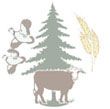Elderberry
Financial Decision Support Tool
The Elderberry Financial Decision Support Tool is an Excel (©Microsoft Corporation) based model designed to assist with elderberry establishment and management decisions. This model allows the user to select multiple options from a list of the most common establishment, management, harvesting and marketing techniques to determine the techniques that will generate the best economic returns. Default methods and costs are based on current elderberry production methods; however, they may be modified by the user.
The EFDST includes an internal yield model that covers a 25-year rotation. In other words, the model assumes that the elderberry plants will be removed or replanted after 25 years. The cost of removal and replant at that time is not included in this model. The model also includes a random variable that reflects the potential yield risks from year to year. More specifically, the random risk variable attempts to model the fluctuations in yield caused by annual weather conditions and other unpredictable events.
Elderberry Economic Decision Model
Management Input
For most users of the model, the Management Input tab is the main interface. All decision variables and financial results are displayed on this page. The Cost Budgets tab provides a printable financial cost budget that can be used as part of a business plan. The Financial Analysis tab provides the cashflow framework for the model. This tab shows the annual yield, revenue and cost predictions from which the financial indicators are calculated.
Input Tables
The Input Tables tab lists all the default decision variables for the model. Any values listed in yellow may be modified by the user of the model. As an example, if a landowner would like to consider a site preparation method that is not listed in the default menu, they may enter the cost on the “User Defined” line of the Site Prep table. This cost will then be incorporated throughout the analysis of the model. For management decisions, such as mulching and weed control, it is possible to adjust when those events will occur by changing the frequency of occurrence and length of occurrence.
Growth Models
The final section of the model is the Growth Models tab. This tab is locked, but is visible to the user of the model. The purpose of this tab is to show the user of the model a graphical representation of the expected yield for the elderberry plants over the 25-year rotation. Across the top of the worksheet are three lines, representing the years and two recommended spacing options. The top line is the year after planting, the second line represents a 4-foot x 12-foot spacing and the third line represents a 2-foot x 12-foot spacing. Below that data there are two charts that show the predicted annual yields with a plotted trendline. The equation of the plotted trendline is programmed into the model as the yield prediction equation for the Financial Analysis tab. These yield equations are based on the best understanding of elderberry production at this time and are considered to be on the “conservative” side.
Financial Indicators
The EFDST uses the financial indicators of net present value (NPV), present value of costs and revenues (PV), annual equivalent value (AEV), modified internal rate of return (MIRR), internal rate of return (IRR), and years to break even. It is important to note that the financial returns of the model represent returns to land and labor. In other words, most of the establishment labor is contracted as part of the cost, the management and harvesting labor is not included in the cost structure. It is also important to note that this model is based on the best information available at this time. It is intended as a guide, but not as a crystal ball. The purpose of this model is to identify how different establishment, management, harvesting and marketing decisions impact the financial outcome of the system. The model is accurate in predicting whether or not a decision will increase or decrease returns. However, it is not intended to provide a “promised” level of income.
Questions or Assistance:
For more information or technical help with the model, contact Zhen Cai, Center Economist, University of Missouri Center for Agroforestry (caiz@missouri.edu).

